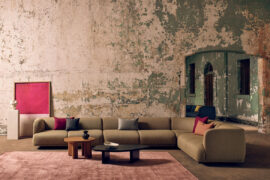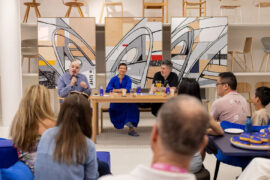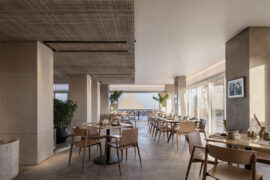The design of a major new exhibition, revealing the rich history of graphic design at one of the world’s most famous art colleges, reflects the cross-disciplinary, collaborative interaction of the institution it celebrates reports Justin Farmer.

November 17th, 2014
Since it started life in 1837 as the Government School of Design, The Royal College of Art (RCA) has played a significant role in shaping the design landscape not only in the UK but across the world; from fine art to architecture and as the centre of the pop art explosion.
When the Graphic Design course opened in 1948, it signalled the beginning of a new era in the education of designers. Out went the old ideas of the ‘Commercial Artist’ and the ‘Poster Artist’, to be replaced by a new concept – the professional graphic designer.
In 1963 the first exhibition of graphic design by students at the Royal College of Art was held. Now the school’s latest exhibition, GraphicsRCA: Fifty Years’, will illustrate how, for the past half century, the RCA has been at the forefront of all major developments in graphic communication.
Such a milestone has called for something a little different. The designs for the exhibition are a collaboration between architects Studio Octopi, Royal College of Art (RCA) School of Communication students, aluminium fabricators and an interior design and build firm.
The initial student concept consisted of a series of display modules referencing equipment and furniture found in print studios. These designs have been developed to create a collection of repeated components that can easily be dismantled for shipping around the World. The exhibition will head overseas when its’ initial London run ends and includes a stint in Hong Kong.
With over a 100 posters to hang, all of varying sizes, the hangers are required to accommodate multiple display configurations. In addition to the posters, a substantial collection of bound materials, including books, magazines and pamphlets, will be showcased in display tables.
The details are repeated for both the hangers and the tables. The kit of parts consists of aluminium ‘connectors’ and oak ‘bars’. Using digital technology the aluminium connectors have all been water cut and then machine-finished.
The expressive aluminium joints are designed to expose the construction process of each item, but also so they could be manufactured in the short timeframe available.
The 45x45mm oak sections are a standard size and finished in a clear matt lacquer.
Stainless steel ‘sex bolts’ connect the elements and thumb-turn bolts clamp the timber hanging bars around the posters.
The exhibition features original, rarely seen works from the RCA archive, including designs made at the College by RCA alumni who have gone on to become leading practitioners.
These include John Pasche’s 1971 lips and tongue logo for the Rolling Stones, commissioned by Mick Jagger whilst Pasche was still a student.
Photography by Dominic Tschudin/RCA
RCA
rca.ac.uk
INDESIGN is on instagram
Follow @indesignlive
A searchable and comprehensive guide for specifying leading products and their suppliers
Keep up to date with the latest and greatest from our industry BFF's!

A curated exhibition in Frederiksstaden captures the spirit of Australian design

Welcomed to the Australian design scene in 2024, Kokuyo is set to redefine collaboration, bringing its unique blend of colour and function to individuals and corporations, designed to be used Any Way!

For Aidan Mawhinney, the secret ingredient to Living Edge’s success “comes down to people, product and place.” As the brand celebrates a significant 25-year milestone, it’s that commitment to authentic, sustainable design – and the people behind it all – that continues to anchor its legacy.

London-based design duo Raw Edges have joined forces with Established & Sons and Tongue & Groove to introduce Wall to Wall – a hand-stained, “living collection” that transforms parquet flooring into a canvas of colour, pattern, and possibility.

Chromatic Cadence by GH Commercial is a new carpet tile range from the Mohawk Group that is inspired by creativity in all shapes.

In Newcastle’s CBD, Coverite Projects transformed a blank floorplate into a workplace with soul, using Milliken flooring to balance industrial grit with residential warmth and intuitive wayfinding.
The internet never sleeps! Here's the stuff you might have missed

Discover the range designed to let people gather and ideas flow

The Richmond precinct will be one of the busiest hubs of Saturday Indesign 2025, with a full program of talks, product launches, installations, hospitality and entertainment running throughout the day.

Despite its long and rich history, signwriting is a profession in decline. Will Lynes’ new show, Oily Water at Canberra Glassworks, aims to showcase the techniques of the trade to highlight its potential in design.

Pedrali’s Nemea collection, designed by Cazzaniga Mandelli Pagliarulo, marks 10 years of refined presence in hospitality and commercial spaces around the world. With its sculptural timber form and enduring versatility, Nemea proves that timeless design is never out of place.